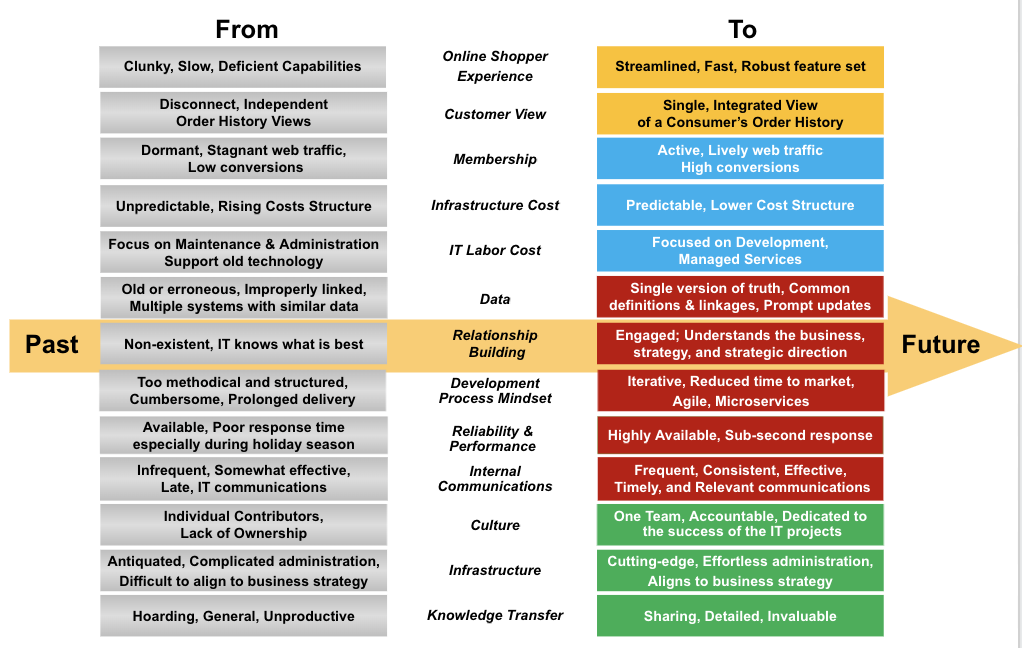Change Agenda
Capture and define the strategy changes or shifts that an organization or engagement needs to achieve in order to realize their desired outcomes
Geoff Probst
What Is Change Agenda?
Change Agenda is a framework used to identify strategic shifts or changes that an organization, team, or engagement needs to achieve in order to realize their desired outcomes. These outcomes could be defined in a vision statement, strategic destination, corporate goals, or an engagement priorities/charter. A change agenda allows a team to identify and access the current state and to define the future state of an environment, strategy or situation via change dimensions. These change dimensions are where the shifts in execution need to occur to realize the outcomes.
Why Do Change Agenda?
The Change Agenda is a powerful communication tool, providing rich context to why the changes are being implemented and how far the organization, team, or engagement is from reaching the desired outcomes, thus triggering useful conversations of what needs to be done to close the execution gap. A Change Agenda helps the leadership articulate and communicate the cultural, structural, and operating changes necessary to transition from the past to the future.
How to do Change Agenda?
The Change Agenda can be created from a client meeting, series of interviews, standalone facilitated practice or as part of a workshop. The goal of this process is to identify and define the strategic shifts that illustrate the change gap the organization needs to address for their strategy and/or engagement.
Interviews
From an interview process perspective, the interviewer identifies components of the change agenda (i.e. change dimensions, current states, and future states) during the conversation. Since an interview is very fluid, these three components could come in any order during the conversation.
As the interviewer identifies any of the components of a change agenda entry, that component should be captured and documented. Follow-up questions should be asked to address the remaining components of that change agenda entry.
If time allows, the change agenda should be reviewed with the interviewee(s) to ensure alignment with client’s expectation of their vision statement, engagement goals, or strategic destination.
Interview Tips:
- Current state definitions are usually identified as a client's pain point
- Future state definitions are usually as a client’s success factor, end state, opportunity, or goals
- Be on the lookout for change dimensions to being supersets of other change dimensions
- Current state definitions are snapshots in time. There might be client push back during a change agenda review as progress might have occurred from the time of the interview and the review
- A template with three columns is helpful when conducting to assist you in make sure you capture all components
Practice / Workshop
Running a change agenda as a practice or part of a workshop, the facilitator starts with a vision statement, engagement goal, or strategic destination and has the participants generate change dimensions.
Affinity mapping can be used to reduce the number of change dimensions
For each change dimension, the facilitator starts with the current state and has the participants create a definition of the current situation. After the current state is complete, the participants need to define the future state.
For both current and future states, use descriptive, colorful language so that readers will be able to visualize the states and recognize that gap between each state.
The completed change agenda needs to be validated against the original vision statement, engagement goal, or strategic destination.
Facilitation Tips:
- For large numbers of participants, the participants can be divided up into groups and change dimensions can be divided up amongst the groups. This avoids the practice from becoming an 8th grade work-smithing experience.
- A walking cafe approach can also be employed to get input from all participants on each change agenda entry before final readout.
- The change dimensions can be classified into perspectives that can be used in a strategy map practice.

This an example of a completed change agenda for a retailer that was migrating an Order History application from on-premise facility to Cloud provider.
Look at Change Agenda
Links we love
Check out these great links which can help you dive a little deeper into running the Change Agenda practice with your team, customers or stakeholders.